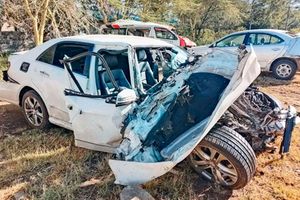New portable device to change face of cancer treatment

A patient undergoes cancer screening at the Integrated Molecular Imaging Center at the Kenyatta University Teaching Referral and Research Hospital on January 10, 2022. Researchers have designed a portable device for diagnosis of cancer.
What you need to know:
- The researchers have identified 11 sites in sub-Saharan Africa — Kenya, Tanzania, Rwanda, Botswana and Malawi — where the device will be rolled out.
- Already, it is in use in Uganda, which was one of the pilot countries. Findings show the device is highly effective and improves the diagnosis of Kaposi’s sarcoma, a common cancer that has, for years, proved very difficult to detect and its symptoms are mistaken for HIV infection.
Kenya is among five countries where people will be tested for cancer in the comfort of their homes through a portable diagnostic device designed by researchers at Cornell Engineering and Weill Cornell Medicine in the US.
The researchers have identified 11 sites in sub-Saharan Africa — Kenya, Tanzania, Rwanda, Botswana and Malawi — where the device will be rolled out.
Already, it is in use in Uganda, which was one of the pilot countries. Findings show the device is highly effective and improves the diagnosis of Kaposi’s sarcoma, a common cancer that has, for years, proved very difficult to detect and its symptoms are mistaken for HIV infection.
Kaposi’s sarcoma forms in the lining of blood and lymph vessels. Its tumours (lesions) appear as painless purplish spots on the legs, feet or face. It is caused by the human immunodeficiency virus and driven by immune suppression from HIV.
According to the International Agency for Research on Cancer at the World Health Organization (WHO), cases of sarcoma cancer in Kenya dropped from number four (in all types of cancer in 2018 to seven in 2019 owing to better HIV and Aids treatment.
Through a $4 million (Sh479,000,000)
grant from the National Cancer Institute Centre for Global Health, the roll-out of the device known as KS-Complete is expanding to areas with less cancer testing capacity and a shortage of pathology experts, incidents that have been leading to long waits and sometimes erroneous results.
In Kenya, for instance, many patients have died in queues in the past as others slept in corridors waiting for diagnosis and treatment that often comes too late.
The device can generate results within an hour at the point of care, hence accelerating accurate diagnosis and treatment.
About 29 per cent of cancer patients in 2019 missed or delayed treatment, the American Cancer Society says. The main barriers to treatment were late diagnoses.
Having a few diagnostic centres in the country is also contributing to late diagnoses, with the number of patients growing by the day.
Kenyan hospitals are poorly equipped to provide cancer treatment. Charges at hospitals with the machines are usually extremely high. Only Kenyatta National Hospital (KNH), Moi Teaching and Referral Hospital and Kenyatta University Teaching, Referral and Research Hospital have comprehensive cancer treatment facilities.
Last year, two out of four machines at KNH, the leading referral facility for cancer treatment in the country, broke down and patients had to wait for months for them to be repaired. This undermined their response to treatment.
With the increase in the number of patients, the cases outweigh the treatment capacity of the machines, hence the frequent breakdown.
Again, poor patients have to dig deeper into their pockets to access treatment at private hospitals while those who are unable skip treatment altogether.
Cancer is the second leading cause of death from non-communicable diseases and the number of cases is rising rapidly. In 2020, 8.3 per cent of the total deaths in the country were due to cancer and, just as pneumonia, more men died than women.
Cancer has also been the leading killer disease among those aged 50-59, accounting for 12.7 per cent of their deaths. The disease affects Kenyans of all ages and socio-economic backgrounds but has a disproportionate impact on the most vulnerable groups.
Cervical cancer makes up the largest portion of cases (nearly 12 per cent), followed by breast cancer, Kaposi’s sarcoma, and oesophageal and prostate cancer.
In many low- and middle-income countries, including Kenya, most cancer cases are diagnosed at an advanced stage — when treatment options are limited and families make huge sacrifices, often with poor results.
“Diagnosis of cancer can be devastating but when diagnosed early, it can be managed and a lot prevented,” said Catherine Naliaka Nyongesa Watta, a Kenyan physician and radiation oncologist.
“It is always advisable to seek medical attention immediately you start feeling unwell.” The project lead, Prof David Erickson, who developed the technology with Dr Ethel Cesarman, professor of pathology and laboratory medicine at Weill Cornell Medicine, said the device is going to improve cancer diagnostic in the said countries as well as treatment.
“This is going to be a game changer. Deploying the device in the countries will definitely change the way Kaposi’s sarcoma is diagnosed in sub-Saharan Africa. Most of those who seek treatment late are as a result of late diagnosis,” he said.
“This is also going to change the waiting time for the results because patients are able to get the results at the comfort of their homes. This will help the patients to access quick care, hence improving clinical outcomes.”
The device consists of two components—Slicer and Tiny. The Slicer processes a biopsy sample into ‘micro-cores’ that can be entered into the pint-sized Tiny (Tiny Isothermal Nucleic acid quantification sYstem).
The Tiny diagnostic identifies the presence of the Kaposi’s sarcoma-associated herpesvirus by isolating and magnifying its DNA through a process called loop-mediated isothermal amplification.
From the clinical tests by the device conducted on 506 biopsies collected from patients at three HIV clinics in Uganda, Tiny achieved 97 per cent sensitivity, 92 per cent specificity and 96 per cent accuracy, according to a study from the project team, which includes researchers from the University of California, San Francisco, and the Infectious Diseases Institute in Kampala, Uganda.
In addition to expanding the KS-Complete deployment, the five-year grant – awarded on June 1 – will focus on refining the Slicer system. And beyond Kaposi’s sarcoma, the researchers are hopeful that the device will in future be used to diagnose other skin diseases.




